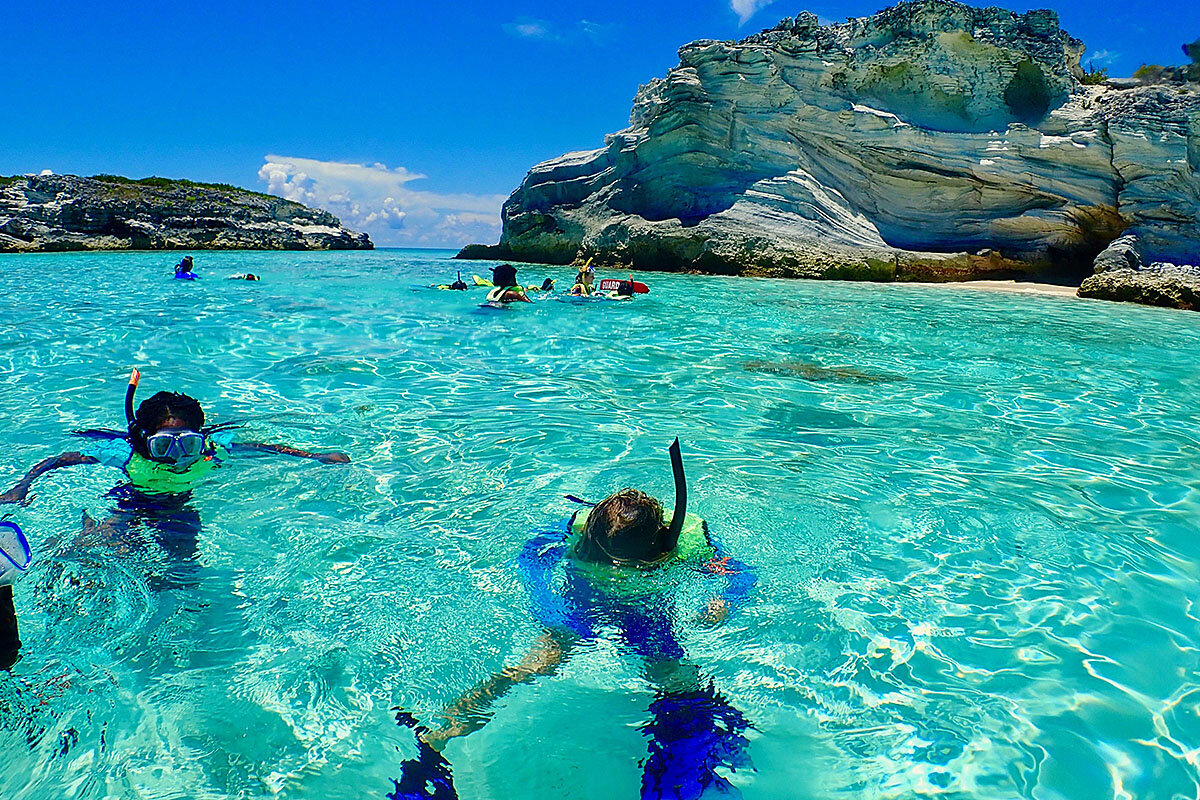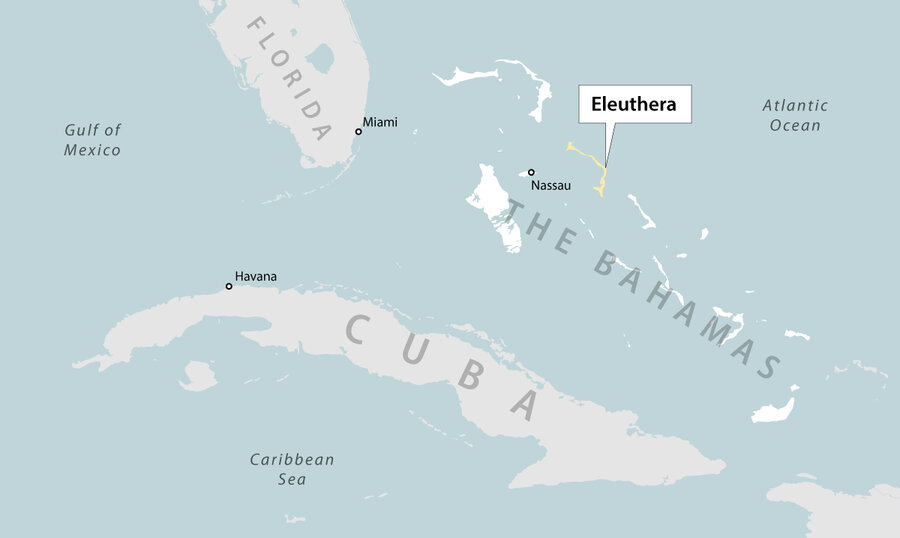Disney cruises put Bahamas to test: Environment or economy?
Loading...
Lighthouse Point, the southernmost tip of the Bahamian island of Eleuthera, is loved by the local community for its vivid blue waters, pink sandy beaches, rocky shorelines, sea turtles, and lemon sharks.
The area contains diverse terrestrial and marine ecologies, including more than 200 bird species and four endemic plant species. The near shore reefs are home to the endangered staghorn coral.
“You don’t see Lighthouse Point,” says Sam Duncombe, president of the environmental group reEarth, “you feel it.”
Why We Wrote This
Natural tourist destinations have to balance profiting from the allure of their environments while keeping them pristine. The cruise ship industry makes the balancing act particularly challenging.
But the pristine landscape is now set to become a cruise ship destination. Disney Cruise Line has received government approval to buy 751 acres of land on Eleuthera for development as a cruise port and entertainment facility. Environmentalists are alarmed, but their repeated warnings have been ignored, the same fate suffered by local proponents of a greener business alternative in the area.
The controversy over the Disney deal, approved before the completion of an environmental impact assessment, is a casebook study of how small island states struggle to strike the right balance between economic development and environmental preservation, especially when those environments are a magnet for tourists in the first place. It also illustrates the challenge that locals, including those with deep ecological and economic knowledge, face when trying to make their arguments heard by the government over those of giant corporations.
“Lighthouse Point is one of the last remaining gems that should be left in perpetuity the way it is for the Bahamian people,” says Shaun Ingraham, head of the One Eleuthera Foundation, which along with Lighthouse Point Partners had envisioned a national park, ecolodge, and educational facilities to create small-scale sustainable development that benefits the community without destroying the environment. “A lot of the great swaths of land and green spaces are being bought up for development and overdevelopment.”
An economic benefit ...
The Caribbean cruise ship industry is booming and the Bahamas are flourishing as a tourism destination, welcoming a record 6.6 million tourists in 2018, the majority of them (4.9 million) cruise passengers. Eleuthera received more than 400,000 arrivals. The Caribbean Council trade organization notes the amount spent by the average cruise visitor falls in the range of $116 to $158 per day.
“The reality is that hundreds of thousands of visitors are gaining their first impressions of the Caribbean from one-day stops on board cruise ships,” the council wrote in a recent report. “The challenge for the region as a whole is now to develop programs ... that actively try to convert cruise visitors to taking a future vacation on land.”
Presenting his annual budget for 2019, Bahamian Minister of Tourism Dionisio D’Aguilar attributed the spike in arrivals to success capturing new markets in China and Latin America, an improved American economy, and a greater breadth of areas visited. While he was clearly pleased with the record in cruise ship arrivals, he was even happier about the smaller but also record-breaking figures for stopover visitors, noting they spend significantly more during their three- to four-night stays.
“We love cruise passengers,” the minister said. “But we love stopover passengers even more since our studies reveal that they spend 20 times more than a cruise passenger.”
The Disney plan for Lighthouse Point is forecast to be an economic boost for the Bahamas. Disney aims to have the site – its second destination in the country – up and running by 2023. A minimum of 120 Bahamians will be employed directly during the construction phase and 150 permanent jobs will result from operations. A potential 20,000 visitors – more than double the island’s population – could disembark at Lighthouse Point each week.
The Bahamas government would lease seabed to Disney for $1,000 per acre per year during the first 10 years. A study by Oxford Economics, which was paid for and cited by Disney in its letter of intent, projects a $805 million increase in Bahamian gross domestic product and a $357 million boost to Bahamian government revenues over 25 years.
...but at an environmental cost
But some locals worry that the Disney project has not been properly vetted. Etoile Pinder, an Eleuthera native and economist, already knew things were heading in the wrong direction when the prime minister visited the island to discuss Disney’s development plans. She was surprised to find the event resembled a pro-Disney rally rather than a genuine town hall discussion about what is best for the community. The “pep rally” mentality was evident in the pro-Disney T-shirts worn by a moderator and others in attendance. Those who raised concerns were booed and ignored, according to her and other witness accounts.
And Ms. Pinder also raises concerns about the economic benefits for Eleutherans. While some job creation is better than none, she points out that of the nearly 100 Bahamians employed at Disney’s private island Castaway Cay, most hold low-level jobs, and only a couple have managerial roles. Eleuthera itself already has a cruise ship port that has done little to improve conditions for depressed communities suffering from high unemployment and low education. Lastly, while private cruise ship ports help passengers avoid the hassle of clearing customs in the capital of Nassau, this also means even less money is spent locally.
“The economic model is based on people spending money on their ships,” Ms. Pinder says, adding that cruise ships bring all the food they need, prepare it on their properties, and don’t pay value-added taxes on it. “This is not a case of them coming to a port like Barcelona, normal tourism with shopping and spending. Here the tourists play in the water, enjoy the beaches, and then get back on the ship.”
Casuarina McKinney-Lambert, executive director of the nonprofit Bahamas Reef Environment Educational Foundation and a native of Eleuthera, believes that ecotourism is the way forward since it is the fastest growing sector. She stresses that cruise ship visitors make up 75% of annual tourist arrivals in the Bahamas, but contribute only 10% of tourism revenue. For her, the environmental costs at Lighthouse Point are far too high relative to the economic benefit.
Ms. McKinney-Lambert is concerned about the environmental toll that building a pier and regular docking will have on the reefs, on protected species of sharks and turtles, and on other wildlife. She is also unconvinced about the so-called economic benefits for a community of less than 10,000 residents, which will be left to process the garbage and sewage of those who come ashore in massive numbers for short hours. Air and water pollution are other areas of concern – the United States Environmental Protection Agency estimates that one ship at sea emits the same sulfur oxide pollution per day as 13 million cars.
“We know that the cruise tourism numbers are increasing, the number of ships that are being built is increasing, and the Bahamas is incredibly appealing as a destination,” Ms. McKinney-Lambert says. “We need to take ownership of our own country and say, ‘Well, what do we want? What is in the best interests of our country?’ And then welcome cruise ships in the way that we Bahamians see fit rather than just depending on what they would like to do.”







